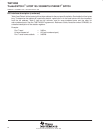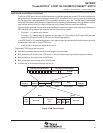
TNETX4090
ThunderSWITCH II
9-PORT 100-/1000-MBIT/S ETHERNET
SWITCH
SPWS044E – DECEMBER 1997 – REVISED AUGUST 1999
28
POST OFFICE BOX 655303 • DALLAS, TEXAS 75265
state of DIO signal terminals during hardware reset
The CPU can perform a hardware reset by writing to an address in the range of 0x40–0x5F (writes to a DMA
address in this range have no effect on reset); this is equivalent to asserting the hardware RESET
terminal with
the following exceptions. During hardware reset, the output and bidirectional DIO terminals behave as shown
in Table 7.
DIO interface continues to operate. The reset condition remains active until SCS is driven high. SRDY does
not become high impedance or resistively pulled high (unlike a true hardware reset), so it still can be used
as a normal acknowledge in this case.
Following the reset, no EEPROM autoload is performed.
Table 7. DIO Interface During Hardware Reset
DIO INTERFACE STATE DURING HARDWARE RESET
SRDY High impedance – resistively pulled up
SDATA7–SDATA0 High impedance – resistively pulled up
STXRDY Driven low
SRXRDY Driven high
IEEE Std 802.1Q VLAN tags on the NM port
Frames received from the host via the NM port are required to contain a valid IEEE Std 802.1Q header (frames
that do not contain a valid IEEE Std 802.1Q header are incorrectly routed). They also can be corrupted at the
transmission port(s) as the tag-stripping process does not check that the four bytes after the source address
actually are a valid tag. The four bytes are a valid tag under all other circumstances.
When a frame is transmitted by the NM port (received by the host), no tag-stripping occurs, so the frame may
contain one or possibly two tags, depending on how the frame originally was received.
frame format on the NM port
The frame format on the NM port differs slightly from a standard Ethernet frame format. The key differences are:
the frame always contains an IEEE Std 802.1Q header in the four bytes following the source address (see
Figure 2). The TPID (tag protocol identifier or ethertype) field, however, is used in the switch for other purposes,
so a frame transmitted out of the switch on the NM port does not have the IEEE Std 802.1Q TPID of 81–00
(ethertype constant) value in these two bytes.
The first TPID byte output contains:
The frame source port number in the least significant bits. This allows the frame source port number to be
carried within the frame, which is useful for processing BPDUs, for example.
A cyclic redundancy check (CRC) type indicator (crctype) in the most significant bit (bit 7).
– If crctype = 1, then the CRC word in the frame excludes the IEEE Std 802.1Q header.
– If crctype = 0, then the CRC word in the frame includes the IEEE Std 802.1Q header. This CRC word is
for a regular IEEE Std 802.1Q frame format with the value in the IEEE Std 802.1Q TPID of 81–00
(ethertype constant) in the TPID field. Because the internal frame format uses the TPID field for other
purposes in the manner being described, it is necessary to insert the IEEE Std 802.1Q TPID of 81–00
(ethertype constant) value into the TPID field if the frame needs to be restored to a normal
IEEE Std 802.1Q frame format, which passes a CRC check.


















